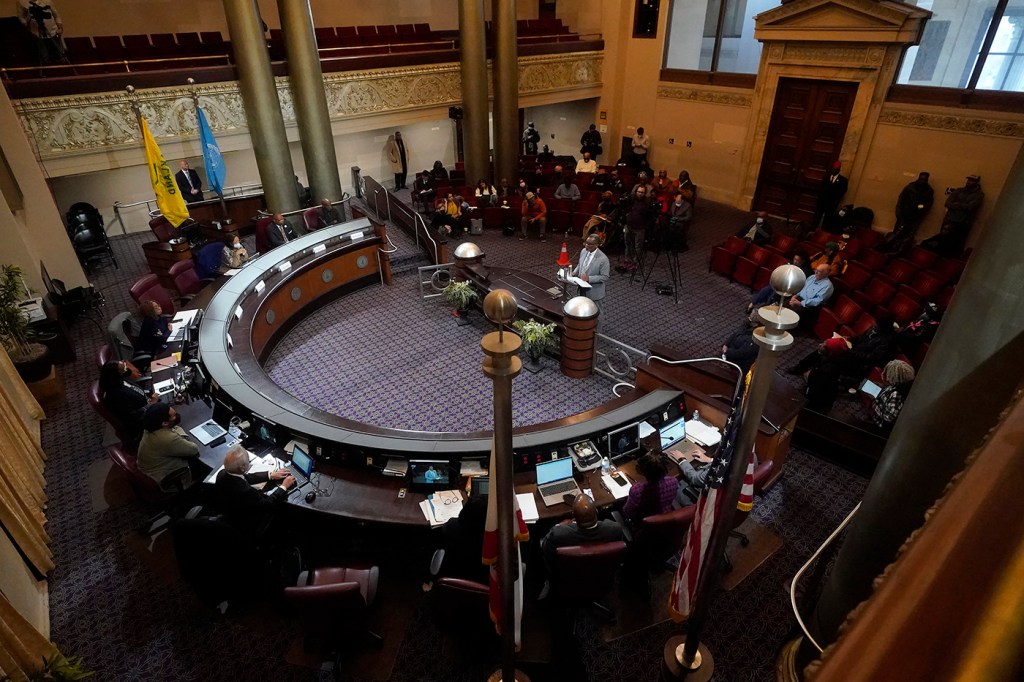‘US history of enslavement’ part of litmus test for Black reparations, experts at Northeastern conference in Oakland say

The Black Reparations Project, an academic initiative at Mills College at Northeastern University, brought together scholars, elected officials and activists from the Bay Area on Friday to discuss what has been done in California and across the country in terms of reparations policies for Black Americans.
In addition to compensation, reparations require other actions at multiple levels of society to achieve holistic repair, experts at the Black Reparations Conference said.
“The U.S. history of enslavement, genocide and racial terror remains the litmus test of U.S. reconciliation efforts,” said Linda Mann, one of the panelists and co-founder of African American Redress Network, which supports organizations on the grassroots, regional and state levels in promoting reparations.
In one of several forums, panelists discussed different frameworks that can guide the work on reparations policies and actions at the federal, state and local levels.
If a state did not protect a person’s fundamental freedoms or human rights, Mann said, then they have a right to seek reparations.
African American Redress Network recognizes five categories of remedies, she said, that must be met to achieve full repair: satisfaction, rehabilitation, restitution, compensation and guarantees of nonrepetition.
It matters greatly how reparations work is framed, Mann said, and material compensation does not always provide meaningful repair.
Some harms can’t be addressed restoratively. However, the perpetrators of those harms must still be held accountable to those victims
Malcolm Clarke, Elizabeth Zitrin Justice Fellow at Civil Rights and Restorative Justice Project at Northeastern University School of Law in Boston
Malcolm Clarke, Elizabeth Zitrin Justice Fellow at Civil Rights and Restorative Justice Project at Northeastern University School of Law in Boston shared with the audience two frameworks that CRRJ uses in its work: restorative justice and transitional justice.
“Both of these frameworks share a focus on truth and accountability, on reconciliation, on participation by all affected parties as elements of the path towards repair,” he said.
Restorative justice framework intends to bring the affected party or the parties back to the state they would have existed in had the wrong not occurred and requires engaging those parties as well as the broader community in that restorative process.
“This framework reparation is about addressing and attempting to facilitate needs of those harmed, it’s not about proportionate compensation for losses suffered by the affected party or parties,” Clarke said.
The transitional justice framework responds to a systemic, widespread human rights violation.
“Some harms can’t be addressed restoratively. However, the perpetrators of those harms must still be held accountable to those victims,” he said. “The harm suffered by the victims must be recognized.”
Experts said transformative justice should include truth telling, compensation, memorialization efforts, criminal prosecution and institutional changes.
“We try to use these frameworks to guide us with reparative processes that we bring to the families we work with, as well as the policies and programs that we support,” Clarke said.
Katie Sandson, program director of Racial Redress and Reparations Lab at CRRJ, said that reparations work is oftentimes driven by and stems from descendant communities and from the grassroots efforts. It also involves a broad range of stakeholders to repair historical harms, ranging from government actors and agencies to private corporations, academic institutions, religious and faith-based organizations.
“There’s certainly an argument that the federal government is the most appropriate target for reparations,” Sandson said. “It’s the entity with the ability to provide reparations at the largest scale within the U.S. context to ensure that you have standard availability of reparations nationally.”
Federal action also played an important role in the harms that were done to Black people, she said, therefore, federal action is absolutely necessary.
The Racial Redress and Reparations Lab has found that state and local governments in the U.S. are not waiting around and advancing reparations within their jurisdictions, within the power and resources that they have available to them, Sandson said.
“A lot of states have been passing or introducing resolutions supporting federal reparations and urging Congress to pass H.R.40 (Commission to Study and Develop Reparation Proposals for African Americans Act),” Sandson said. “They’re introducing bills to move things forward at the state level themselves as well.”
This is not necessarily just happening in “blue” states or on the West Coast or in the Northeast, she said; however, a lot of proposed legislation and ordinances on the state or local level are nonbinding. Most of the bills introduced do not become laws.
“Truth-seeking eventually does lead to material reparation,” Sandson said. “There might need to be more creative strategies in different places.”
Mann said that descendant, harmed communities should lead reparations work, supported by organizations like AARN and RRRJ, because they are knowledge producers and experts in what harm had been done and what meaningful repairs their community needs.
During another panel at the conference, attendees learned about the work of the California Reparations Panel Taskforce, which studies the institution of slavery and its lingering negative effects on living African Americans, and watched municipal presentations on reparations from a number of cities in the Bay Area.
The taskforce is expected to submit its final proposals for California’s first-of-its-kind statewide reparations program by July 1. This proposal might kickstart the legislative process that can monumentally shift the lives of Black Americans across the country.
A third panel of the conference focused on philanthropy that was made possible because of centuries of exploitation of Black communities to build wealth and how such philanthropy could now support the movement for Black reparations.
After hours of rich discussions, of special importance was the final panel on joy and wellness that wrapped up the conference. It engaged participants in gentle movement, breathwork, and meditation and encouraged a collective discussion of their place in reparations work.
Alena Kuzub is a Northeastern Global News reporter. Email her at a.kuzub@northeastern.edu. Follow her on Twitter @AlenaKuzub.





